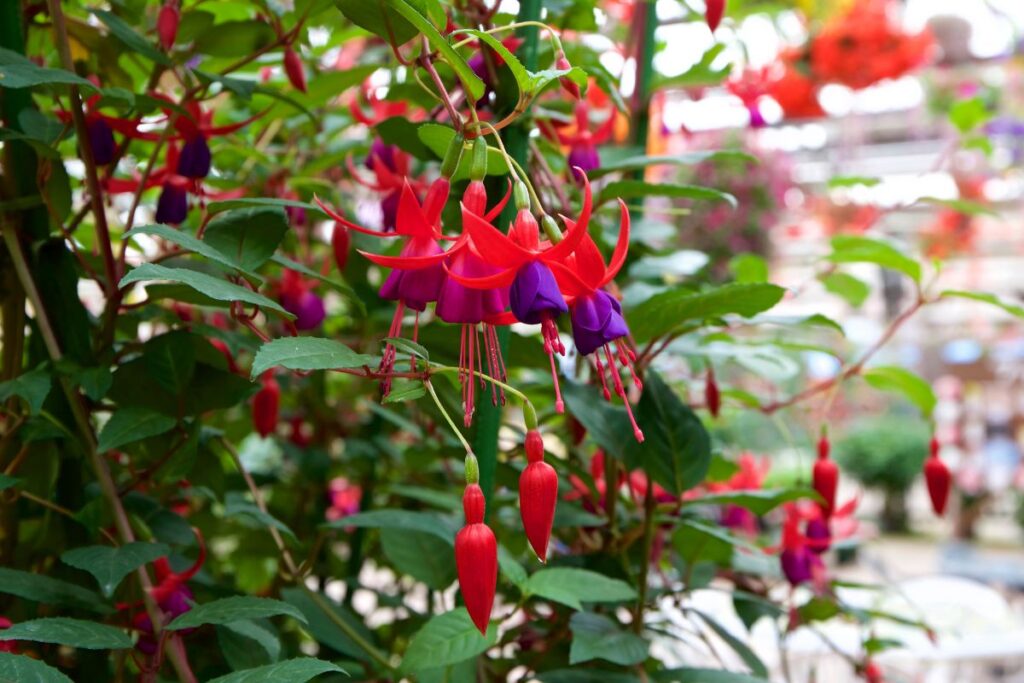Want a splash of color in your winter garden?
Hardy fuchsias are the answer!
Learn how to grow and care for these resilient plants for vibrant blooms all winter long.
Ready to transform your garden?
Let’s get started!
Best Time to Plant Hardy Fuchsias

The optimal time to plant hardy fuchsias is mid to late spring. This allows them to develop strong roots before the cold sets in, ensuring they can withstand freezing temperatures and grow again in spring.
Start by selecting the right location and amending the soil appropriately.
Let’s explore this further!
Choosing the Right Spot
When selecting a spot for your hardy fuchsias, look for areas that get partial shade. This helps protect them from strong sunlight during midday. Incorporate perlite or vermiculite into the soil to enhance drainage and mix in compost for added nutrients.
Mixing fuchsias with other shade-tolerant plants that can withstand cooler temps can create an interesting garden contrast. Combining various plants adds both beauty and resilience to your garden.
Planting Techniques
Create a hole a bit bigger than the plant’s root ball. Place the fuchsia carefully in the hole, making sure it sits at the same depth as in its original pot. Fill the hole back in, water it well, and think about adding a mulch layer. This step helps keep the soil moist and prevents weed growth.
Different Types Available
- Fuchsia ‘Lady Boothby’ – This climbing type has green leaves and deep pink-to-purple flowers.
- Fuchsia ‘Alce Hoffman’ – A bushy plant with white-pink flowers and bronze-green leaves, great for bigger pots.
- Fuchsia ‘Mrs Popple’ – Known for upright growth and flowers that bloom throughout summer and fall.
- Fuchsia ‘Rose of Castile’ – This vigorous plant grows upright and produces striking purple-pink flowers.
- Fuchsia ‘Beacon’ – Features pink-purple flowers and pairs well with plants like heucheras.
- Fuchsia ‘Brutus’ – A free-flowering variety with intense pink and purple blossoms.
- Fuchsia magellanica – An elegant choice with rich purple flowers and lush green leaves, typically larger than other types.
Adding these diverse fuchsias to your garden not only enhances its visual appeal but also provides year-round interest.
Caring for Hardy Fuchsias

Moist Soil: Hardy fuchsias thrive in consistently moist soil. Water them deeply whenever the top inch of soil feels dry, especially during dry spells.
Fertilization: During the growing season, use a balanced, water-soluble fertilizer. A high potash fertilizer, such as tomato food, is a good option. If your fuchsias are in pots, feed them once a week.
Deadheading: Remove spent flowers regularly. This practice will help extend the flowering period.
Pruning: In mid-spring or after the last frost, prune your fuchsias. Trim back any frosted stems to live wood or to the base if the damage is severe.
Winter Protection: Although hardy fuchsias can handle cooler temperatures, it’s a good idea to protect them during winter. Mulch around the base in late autumn to keep roots insulated. In very cold areas, consider adding straw or garden fleece for added protection.
Pest Control: Watch out for capsid bugs. These pests suck sap from new shoots, weakening the plant. To combat them, introduce natural predators like birds or ground beetles to your garden.
Propagating Hardy Fuchsias
You can propagate hardy fuchsias by taking hardwood cuttings in late fall. Select a pencil-thick woody stem and cut a section about 15 cm long, trimming just below a pair of leaves at the base. Remove the two lowest leaves.
Prepare a container with peat-free compost, making sure it’s firm and well-watered. Insert the cuttings around the edge of the pot, ensuring that about half of each cutting is submerged in the compost.
Keep the compost slightly moist and place the pot in a cool, frost-free spot like a cold frame or an unheated greenhouse. By spring, you should notice new shoots. When the cuttings have leaves and are growing well, transfer them to separate pots in late spring.
In early summer, plant them in their final growing positions and take care of them as they continue to flourish.

